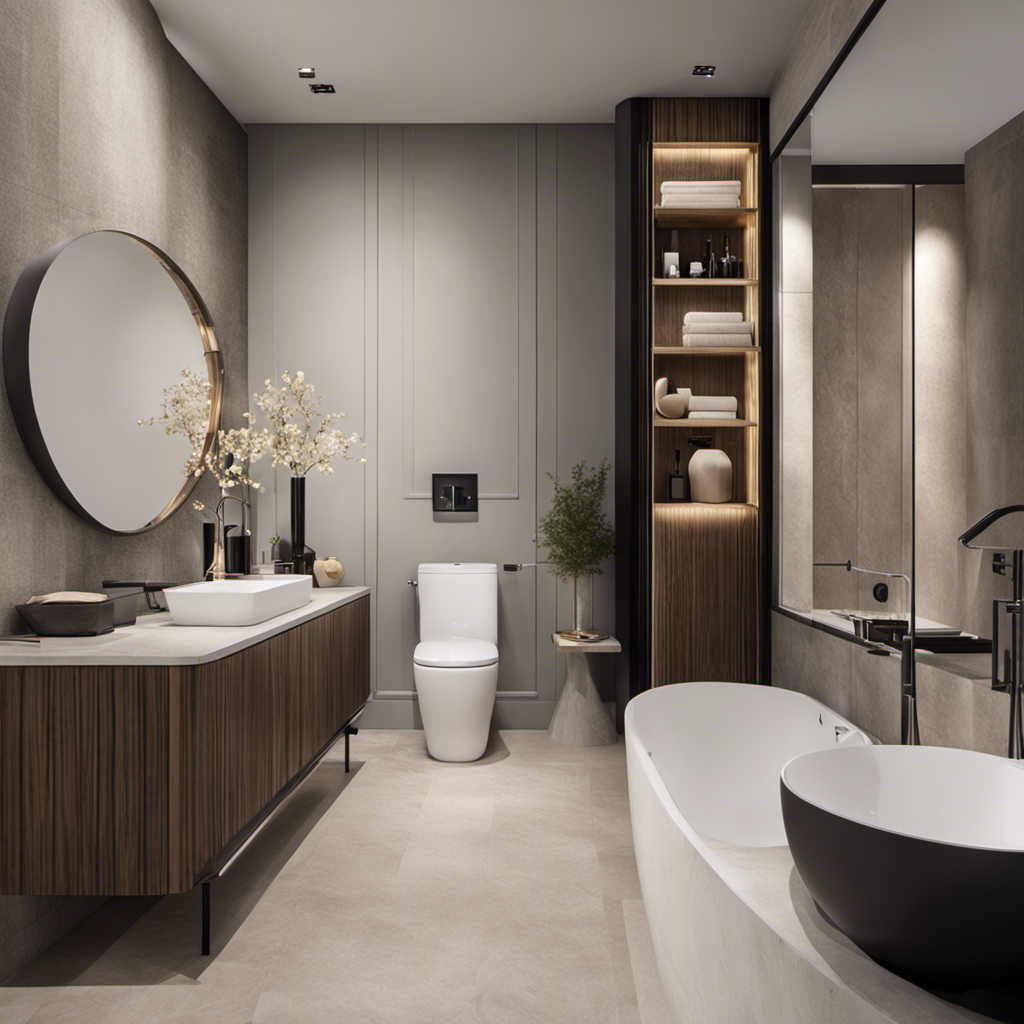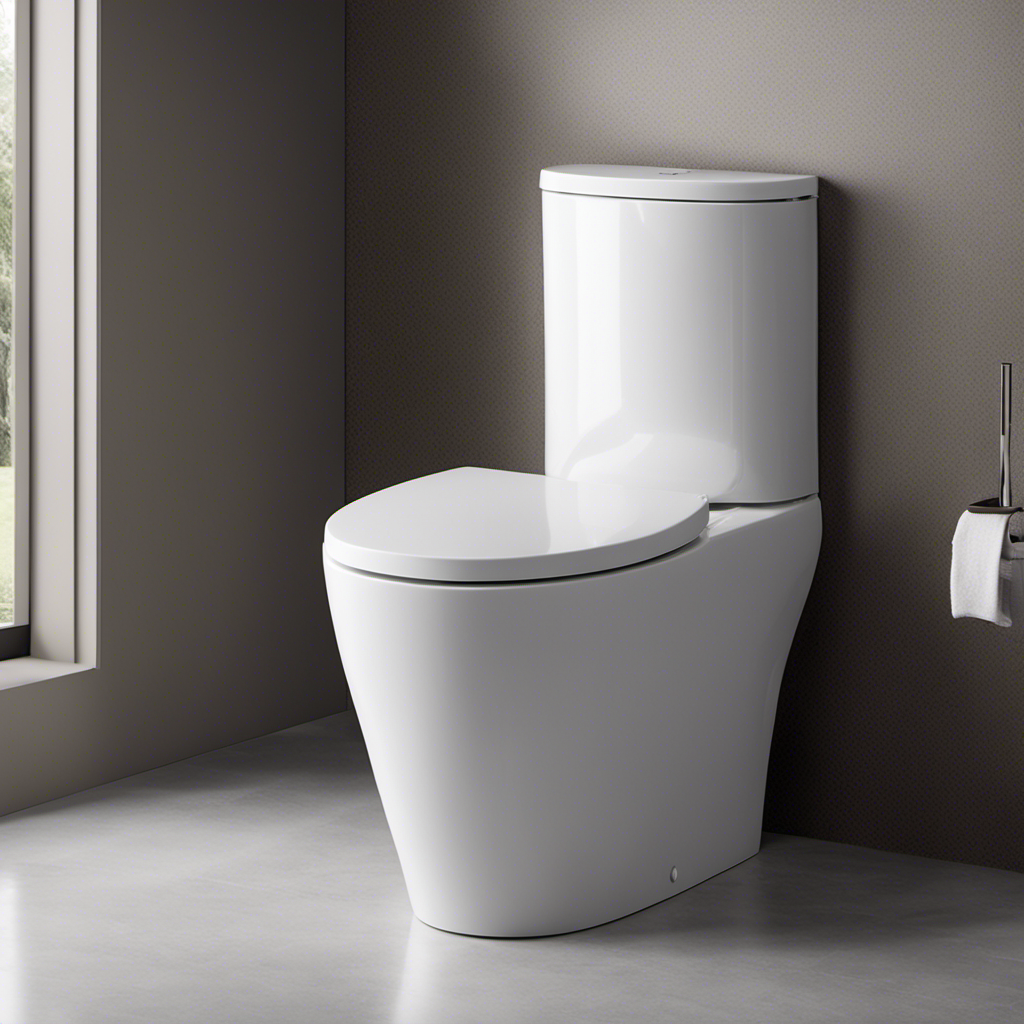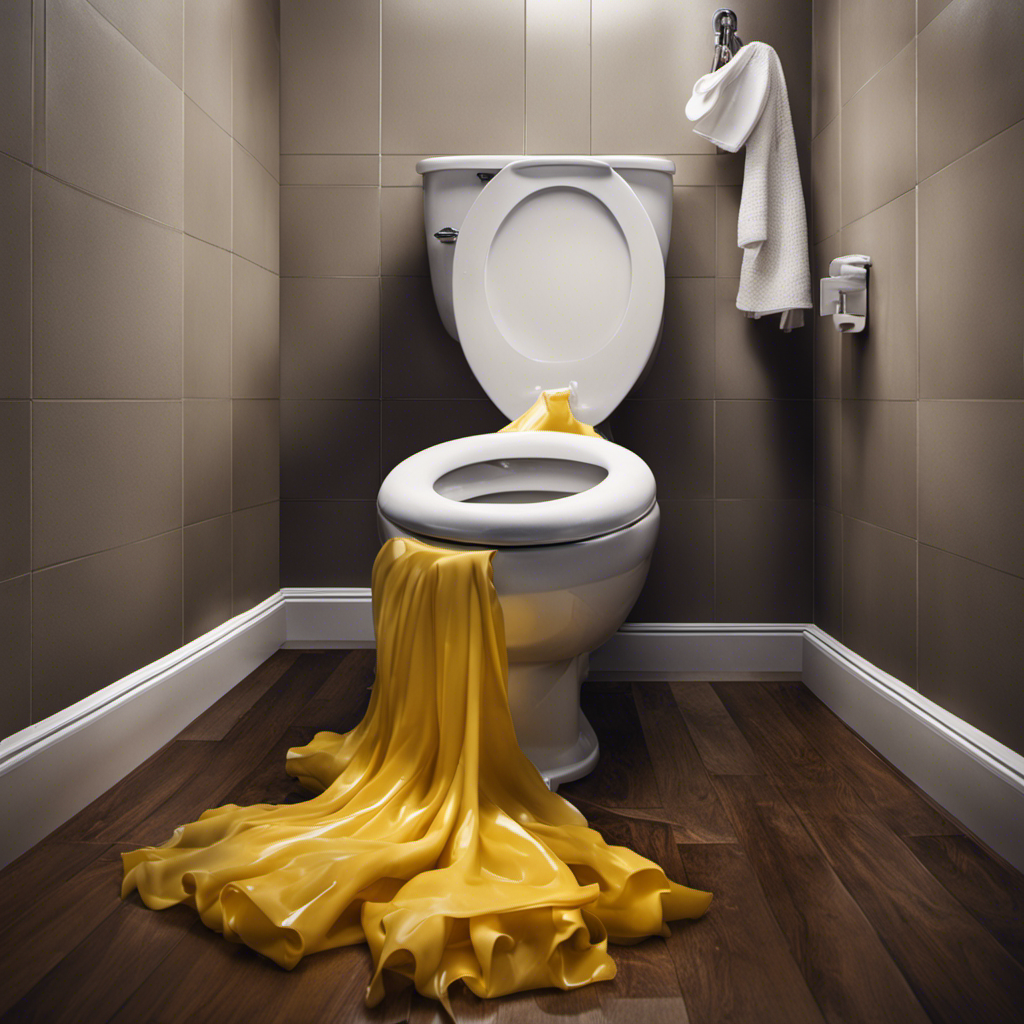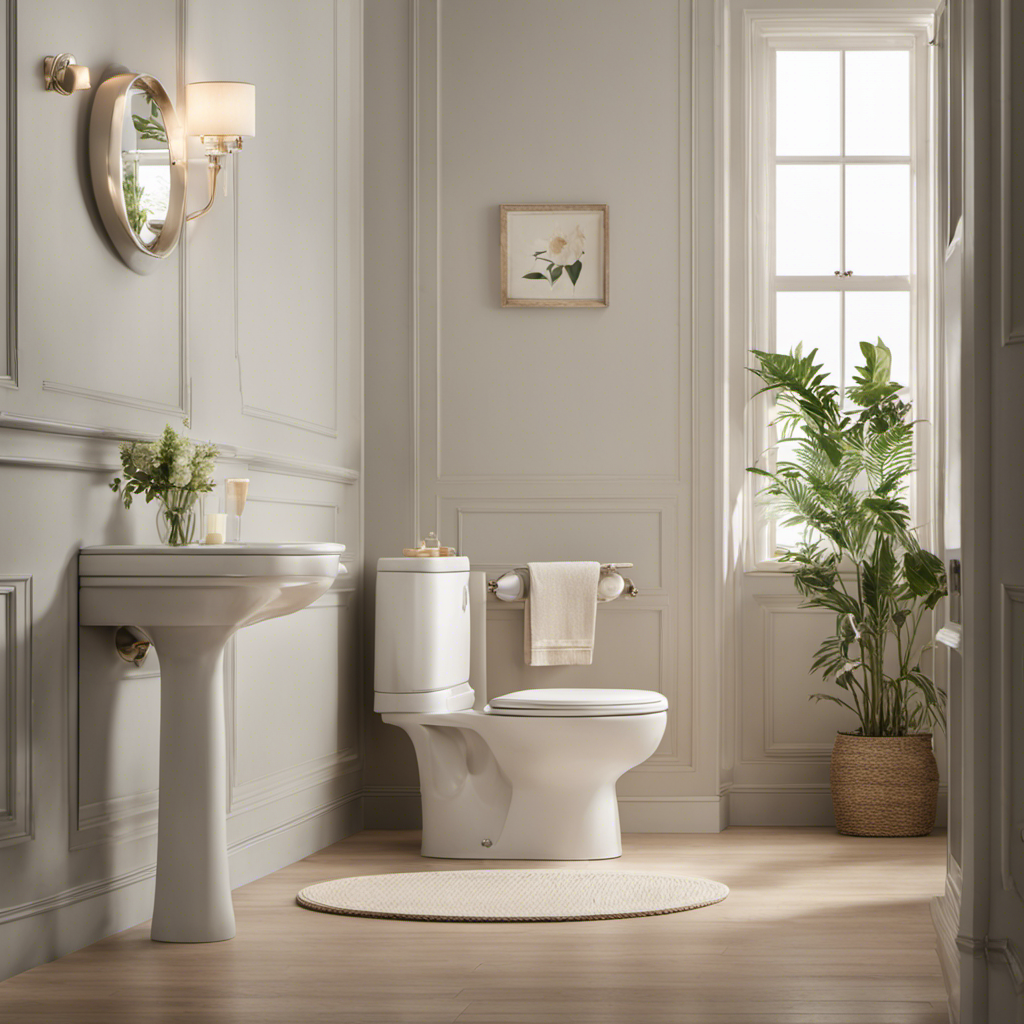I gotta tell you, folks, comfort is the name of the game when it comes to toilets. And let me tell you, a comfort height toilet is where it’s at.
In this article, we’re diving deep into what exactly a comfort height toilet is, and why it’s worth considering for your bathroom. We’ll be covering everything from the benefits and measurements, to choosing the right one and even the impact on accessibility.
So sit back, relax, and get ready to learn all about the wonders of comfort height toilets.
Key Takeaways
- Comfort height toilets are designed to be taller than standard toilets, providing easier sitting and standing for those with mobility issues or physical limitations.
- They promote better posture and reduce the risk of injury by reducing strain on the knees and back.
- Comfort height toilets offer a more comfortable and convenient experience, increasing user satisfaction.
- Understanding height measurements such as comfort height, ADA compliance, chair height, and standard height helps in choosing a toilet that suits specific needs and provides optimal comfort and accessibility.
Benefits of a Comfort Height Toilet
You’ll appreciate the benefits of a comfort height toilet. They are designed to be taller than standard toilets, typically measuring between 17 to 19 inches in height. This extra height makes it easier for users to sit down and stand up, especially for those with mobility issues or physical limitations. The reduced strain on the knees and back promotes better posture and reduces the risk of injury.
Additionally, comfort height toilets are known to increase user satisfaction. They provide a more comfortable and convenient experience. Many people find them to be more ergonomic and easier to use, leading to a higher level of overall satisfaction.
Understanding the Height Measurements
Understanding the measurements can help you choose the right toilet for your needs. When it comes to toilet dimensions, height is an important factor to consider. Here are four key points to help you understand height measurements:
-
Comfort Height: This refers to the standard height of a toilet, which is typically around 17 to 19 inches from the floor to the top of the seat. It is designed to provide ease of use for people with mobility issues or those who prefer a higher seating position.
-
ADA Compliance: The Americans with Disabilities Act (ADA) requires toilets in public spaces to have a minimum height of 17 to 19 inches. This ensures accessibility for individuals with disabilities.
-
Chair Height: This term is often used interchangeably with comfort height. It reflects the idea that the toilet is designed to be at a similar height to a chair, making it easier to sit down and stand up.
-
Standard Height: A standard height toilet is typically around 14 to 15 inches from the floor to the top of the seat. These toilets are more suited for children or individuals who prefer a lower seating position.
Understanding these height measurements can help you choose a toilet that best suits your needs and provides optimal comfort and accessibility.
How to Choose the Right Comfort Height Toilet
When selecting the perfect toilet for your needs, it’s important to consider the ideal seating position that provides maximum comfort and accessibility. One of the key factors to consider is choosing the right size, as comfort height toilets come in various dimensions to accommodate different individuals. To aid you in making an informed decision, here is a table outlining the size options available:
| Size Option | Seat Height (inches) | Width (inches) | Depth (inches) |
|---|---|---|---|
| Standard | 15-16.5 | 14-16.5 | 25-28.5 |
| Comfort | 17-19 | 16-18 | 28-30.5 |
| Extra tall | 19-21 | 18-20 | 30-32.5 |
Once you have chosen the right size, it’s important to ensure that the seat height is adjustable to meet your specific needs. This feature allows for customization and optimal comfort. Now that you have a better understanding of how to choose the right comfort height toilet, let’s move on to the next topic, which covers the installation and maintenance of these toilets.
Installation and Maintenance of Comfort Height Toilets
When it comes to the installation and maintenance of comfort height toilets, there are several key points to keep in mind.
First and foremost, proper installation techniques are crucial to ensure the toilet functions correctly and securely.
Secondly, cleaning and sanitizing tips are essential to maintain hygiene and prevent any build-up of bacteria or odors.
Lastly, being aware of common maintenance issues can help identify and address any problems that may arise, ensuring the longevity and efficiency of the comfort height toilet.
Proper Installation Techniques
To ensure proper installation of a comfort height toilet, you should follow the manufacturer’s instructions and use the recommended tools. Here are some important techniques to keep in mind:
-
Leveling: Start by ensuring that the floor is level before installing the toilet. Use a level to check for any unevenness and make necessary adjustments.
-
Sealing: Properly seal the base of the toilet to prevent any leaks. Apply a thin bead of silicone caulk around the edge of the toilet base before placing it on the flange.
-
Bolts and Washers: Use the provided bolts and washers to secure the toilet to the flange. Tighten them evenly to ensure a secure and stable connection.
-
Testing: After installation, thoroughly test the toilet for any leaks by flushing multiple times and checking for any water seepage around the base.
Cleaning and Sanitizing Tips
Here’s a simple way to keep your bathroom clean and sanitized: regularly wipe down surfaces with disinfectant wipes. This cleaning technique is essential for proper sanitation and helps prevent the spread of germs and bacteria. When using disinfectant wipes, pay special attention to high-touch areas such as faucets, doorknobs, and toilet handles. Make sure to follow the instructions on the wipes’ packaging for effective cleaning.
Additionally, it’s important to clean your toilet bowl regularly using a toilet brush and a disinfectant cleaner. This will help remove any stains, odors, and bacteria that may accumulate over time.
By maintaining a regular cleaning routine, you can ensure a clean and hygienic bathroom environment.
Now, let’s move on to common maintenance issues that you may encounter with your toilet.
Common Maintenance Issues
If you notice any leaks or running water in your bathroom, it’s important to address these common maintenance issues promptly. Here are some toilet repair troubleshooting tips to help you resolve these issues:
-
Check for leaks: Look for water around the base of the toilet or on the floor. This could indicate a faulty wax ring or loose connections.
-
Test the fill valve: If your toilet keeps running, the fill valve may be the culprit. Adjust the water level or replace the valve if necessary.
-
Unclog the toilet: A plunger is often the best tool for clearing a clogged toilet. Use firm, consistent pressure to create suction and dislodge the blockage.
-
Replace worn parts: If your toilet is constantly running or not flushing properly, it may be time to replace worn-out components like the flapper or flush valve.
By addressing these common maintenance issues promptly, you can keep your toilet functioning properly and avoid more costly repairs down the line.
Now, let’s move on to comparing comfort height toilets with standard height toilets.
Comparing Comfort Height Toilets With Standard Height Toilets
Comfort height toilets are typically preferred over standard height toilets for their added convenience and accessibility. When comparing the two, comfort height toilets have several benefits.
First, they are designed to be taller, making it easier for people with mobility issues or disabilities to sit down and stand up. This can greatly improve the overall comfort and independence of individuals. Additionally, comfort height toilets are also beneficial for taller individuals who may find standard height toilets uncomfortable to use.
However, there are some drawbacks to consider. Comfort height toilets may not be suitable for shorter individuals or children, as the increased height can make it more difficult for them to use the toilet comfortably. It is important to carefully consider the needs and preferences of all users when choosing between comfort height and standard height toilets.
Transitioning to the subsequent section, the impact of comfort height toilets on accessibility will be explored further.
The Impact of Comfort Height Toilets on Accessibility
Transitioning to comfort height toilets can greatly improve accessibility for individuals with mobility issues or disabilities, making it easier for you to comfortably sit down and stand up. Here are four ways in which comfort height toilets enhance user satisfaction and ease of use:
-
Increased Seat Height: Comfort height toilets are typically 17 to 19 inches tall, compared to the standard height of 14 to 15 inches. This height difference allows for a more natural and comfortable posture when using the toilet.
-
Reduced Strain on Joints: The higher seat position of comfort height toilets reduces the strain on the knees, hips, and back, making it easier for individuals with limited mobility or disabilities to sit down and stand up without excessive effort or discomfort.
-
Better Stability: Comfort height toilets often come with wider bases and sturdier construction, providing better stability and support. This added stability is especially beneficial for individuals who require assistance or rely on mobility aids.
-
ADA Compliance: Many comfort height toilets meet the standards set by the Americans with Disabilities Act (ADA). This means that they are designed to accommodate individuals with disabilities and offer features such as grab bars and sufficient space for maneuverability.
Transitioning to comfort height toilets can significantly enhance accessibility and improve the overall comfort and ease of use for individuals with mobility issues or disabilities. Now, let’s explore some real-life experiences with comfort height toilets.
Real-Life Experiences With Comfort Height Toilets
In my experience, comfort height toilets have consistently shown high user satisfaction levels. The increased height of these toilets makes them much easier to use, especially for individuals with mobility issues or disabilities.
Additionally, the accessibility benefits of comfort height toilets cannot be overstated, as they provide a more inclusive and accommodating bathroom experience for all users.
User Satisfaction Levels
Are you happy with how comfortable the comfort height toilet is? Based on user satisfaction levels and real-life experiences, here are four key factors that contribute to the overall satisfaction with comfort height toilets:
-
Height: The increased height of comfort height toilets provides better accessibility and reduces strain on the knees and back, resulting in improved comfort for users of all ages and abilities.
-
Ease of Use: The higher seating position makes it easier for users to sit down and stand up, especially for those with mobility issues or limited strength. This feature enhances the overall user experience and promotes independence.
-
Safety: Users appreciate the added safety features, such as sturdy construction and grab bars, which provide stability and support while using the toilet. This reassurance contributes to higher levels of satisfaction.
-
Versatility: Comfort height toilets are available in a wide range of styles and designs, allowing users to choose a model that matches their personal preferences and bathroom aesthetics. This customization option adds to the overall satisfaction with these toilets.
Ease of Use
In terms of user satisfaction, the ease of use of a comfort height toilet is a crucial factor. These toilets are designed with ergonomics in mind, ensuring a user-friendly experience for all individuals. The higher seat of a comfort height toilet makes it easier for people with mobility issues or physical limitations to sit and stand up without straining themselves. The user-friendly design is further enhanced by the inclusion of features such as handrails and grip pads, providing additional support and stability. This ensures that using a comfort height toilet is not only comfortable but also safe for all users. The table below provides a comparison of the ease of use of a comfort height toilet versus a standard height toilet:
| Aspect | Comfort Height Toilet | Standard Height Toilet |
|---|---|---|
| Seat Height | Taller | Lower |
| Ease of Access | Easier | More challenging |
| Support | Enhanced | Limited |
| User Experience | Comfortable | Less comfortable |
Overall, the ease of use of a comfort height toilet is superior, making it an ideal choice for individuals seeking a user-friendly and ergonomic toilet option.
Accessibility Benefits
The higher seat of a comfort height toilet makes it easier for individuals with mobility issues or physical limitations to sit and stand up without straining themselves. This feature provides several benefits to users, enhancing their overall experience:
-
Improved Accessibility: The increased height of the toilet seat reduces the distance between standing and sitting positions, making it more accessible for people with limited mobility or strength. This allows for greater independence in performing daily tasks.
-
Reduced Strain: By reducing the need for excessive bending or squatting, comfort height toilets minimize strain on the knees, hips, and back. This can be particularly beneficial for individuals with arthritis, joint pain, or recovering from surgery.
-
Enhanced Safety: The higher seat of a comfort height toilet reduces the risk of falls or accidents while transitioning from standing to sitting and vice versa. This ensures a safer experience for users, especially older adults or those with balance issues.
-
Inclusive Design: Comfort height toilets are designed to accommodate a wide range of users, promoting inclusivity and accessibility in homes, public facilities, and healthcare settings. This user-centric approach ensures that everyone can enjoy a comfortable and convenient bathroom experience.
Conclusion
In conclusion, comfort height toilets offer numerous benefits for individuals of all abilities. The higher seat height provides ease of use and promotes better posture while using the toilet.
Choosing the right comfort height toilet requires consideration of the measurements and personal preferences. Proper installation and maintenance ensure optimal performance and longevity.
When compared to standard height toilets, comfort height toilets clearly stand out in terms of accessibility and user comfort. So, why settle for discomfort when you can elevate your bathroom experience with a comfort height toilet?










